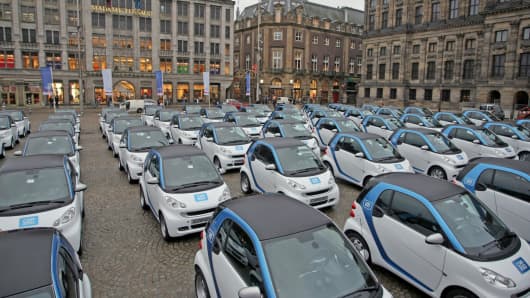CNBC.com: Amsterdam is synonymous with three things: canals, coffee shops and cycling. There are around 400km of cycle paths in the city, making getting around by bike a safe, popular and environmentally friendly way of traveling for a large number of residents.
Since 2009, the city has been promoting the adoption of another form of sustainable transport: electric vehicles. The initiative, known as Amsterdam Elektrisch – or Amsterdam Electric – has seen a raft of measures introduced in the city to encourage uptake of clean, electric transport.
Maarten Linnenkamp, who was responsible for the introduction of the scheme in 2009 and is now Project Manager for the city's metropolitan area, said Amsterdam's willingness to be pro-active when it came to electric vehicles was key.
"Five years ago, nobody knew hardly anything about electric mobility, so we thought: don't talk, but act," he told CNBC in a phone interview.
This willingness to act saw many incentives introduced to encourage people to buy or use electric cars.
During the scheme's "launch phase" those using electric vehicles in the city were offered not only free access to charging points, but free parking too. Today, 'e-drivers' are automatically placed at the head of parking space waiting lists.

"It can take a year or more to get a parking permit," Bart Vertelman, Project Manager of the electric mobility program in the city of Amsterdam, told CNBC.com in a phone interview. "When you buy an electric car you get to the top of the list… which is a big advantage in a city like Amsterdam," he added.
According to data compiled by Amsterdam Electric, in 2013 and the first half of 2014, 2.2 million kilowatt hours of energy were charged using public charging points, which is equivalent to 11 million clean, emission free kilometers. An electric car sharing scheme with car2go has put a further 300 fully electric vehicles on the roads.
Accessibility to charging points has been crucial to the program's success. "All kinds of cities put [charging] infrastructure on the street, just to make it visible, [to say] 'look at us, we have electric mobility'," Vertelman said. "But… infrastructure was put in front of the city hall, for example. Nobody is going to charge in front of city hall, it's not where they live or where they work," he added.
"We made it demand driven, basically at the places where people live and work, so they can ask us, 'I live here, I work here, is it possible to put a charging point on the street?'"
By 2015, it is hoped that there will be 2,000 public charging points throughout Amsterdam, while this autumn will see the introduction of an electric taxi service from Amsterdam's Schiphol airport.
Why has electric transport been such a success in Amsterdam? "In the Netherlands as a whole, it's quite suitable to use electric cars," Linnenkamp said. "The distances are not that big, the climate is OK, we don't have mountains and people are well educated and interested in new things," he added.
Since 2009, the city has been promoting the adoption of another form of sustainable transport: electric vehicles. The initiative, known as Amsterdam Elektrisch – or Amsterdam Electric – has seen a raft of measures introduced in the city to encourage uptake of clean, electric transport.
Maarten Linnenkamp, who was responsible for the introduction of the scheme in 2009 and is now Project Manager for the city's metropolitan area, said Amsterdam's willingness to be pro-active when it came to electric vehicles was key.
"Five years ago, nobody knew hardly anything about electric mobility, so we thought: don't talk, but act," he told CNBC in a phone interview.
This willingness to act saw many incentives introduced to encourage people to buy or use electric cars.
During the scheme's "launch phase" those using electric vehicles in the city were offered not only free access to charging points, but free parking too. Today, 'e-drivers' are automatically placed at the head of parking space waiting lists.

"It can take a year or more to get a parking permit," Bart Vertelman, Project Manager of the electric mobility program in the city of Amsterdam, told CNBC.com in a phone interview. "When you buy an electric car you get to the top of the list… which is a big advantage in a city like Amsterdam," he added.
According to data compiled by Amsterdam Electric, in 2013 and the first half of 2014, 2.2 million kilowatt hours of energy were charged using public charging points, which is equivalent to 11 million clean, emission free kilometers. An electric car sharing scheme with car2go has put a further 300 fully electric vehicles on the roads.
Accessibility to charging points has been crucial to the program's success. "All kinds of cities put [charging] infrastructure on the street, just to make it visible, [to say] 'look at us, we have electric mobility'," Vertelman said. "But… infrastructure was put in front of the city hall, for example. Nobody is going to charge in front of city hall, it's not where they live or where they work," he added.
"We made it demand driven, basically at the places where people live and work, so they can ask us, 'I live here, I work here, is it possible to put a charging point on the street?'"
By 2015, it is hoped that there will be 2,000 public charging points throughout Amsterdam, while this autumn will see the introduction of an electric taxi service from Amsterdam's Schiphol airport.
Why has electric transport been such a success in Amsterdam? "In the Netherlands as a whole, it's quite suitable to use electric cars," Linnenkamp said. "The distances are not that big, the climate is OK, we don't have mountains and people are well educated and interested in new things," he added.